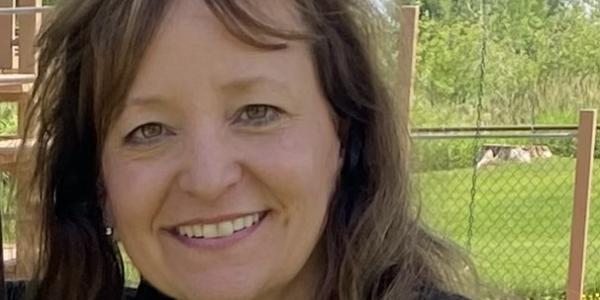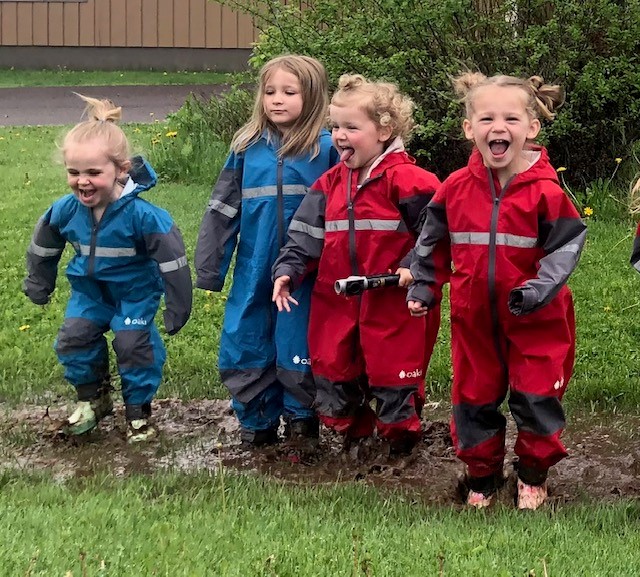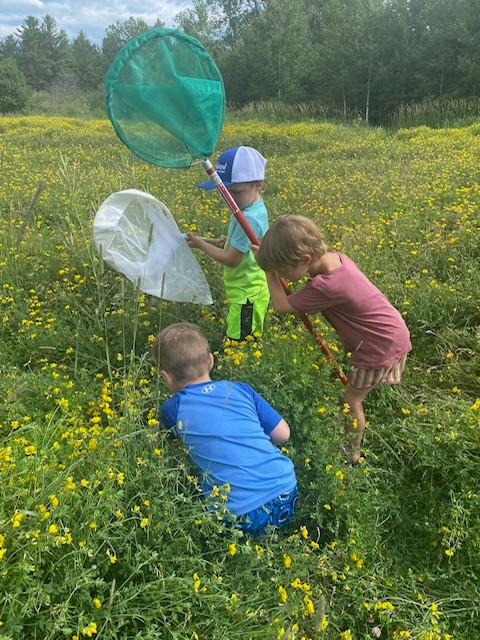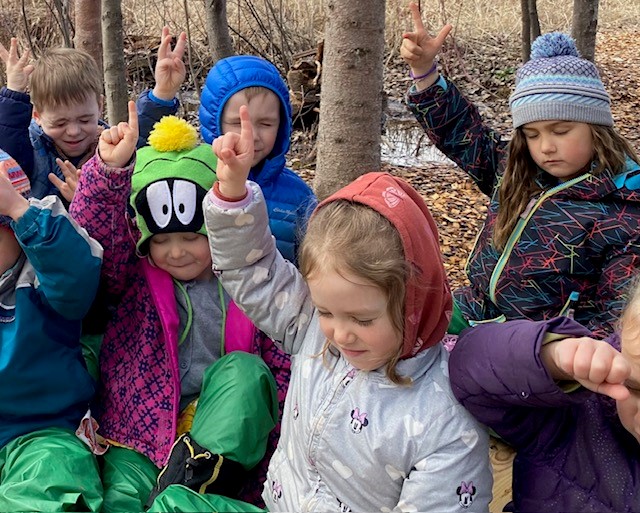Member Spotlight: Theresa Fredericks

You are here
For more than 50 years, Tree Top Child Development Center and Preschool has served families in the Ashland, Wisconsin, area. That is no mean feat, given the pressures facing the early childhood education field. Yet Theresa Fredericks—owner and director of the center and one of its teachers—continues to meet these challenges through innovation, outreach, and advocacy. For example, Theresa pivoted to outdoor learning when COVID-19 struck. She tapped her community when searching for staff. She has spoken to lawmakers about the struggles early childhood educators face in her state. As Tree Top begins its second half-century, we look forward to seeing what is next for Theresa and her program.
—Michelle Kang, Chief Executive Officer
Spend some time with Theresa Fredericks, and a theme will soon emerge.
Family.
It makes sense. When Theresa was 5 months old, her mother began Tree Top Child Development Center and Preschool to serve children and families in Ashland, Wisconsin, a small port city on Lake Superior. Theresa bought the business in 2009. Today, she and her staff of nine serve 33 infants, toddlers, and preschoolers.
Since the COVID-19 pandemic, Tree Top has embraced a nature-based curriculum that largely takes place outside—making use of the prairie trails, fields, and forest that abut Theresa’s home. The center celebrated its 50th anniversary last summer. It remains one of just a handful of early childhood programs in the Ashland area. During a recent conversation, Theresa talked about nature, NAEYC, and the challenges and rewards of directing an early learning program. These are excerpts.

Tree Top is part of your family history. What was it like taking on the legacy of a program your mother began?
I spent my childhood at Tree Top, so this was a natural progression. My mom was my mentor. She became my best friend. When she began Tree Top, she was a young mother who had taken a basic early childhood course. She was progressive back then: As I was digging through things as we got ready to celebrate 50 years, I found journals that she kept from her very first days. She knew what “developmentally appropriate” meant before it was commonplace in our field. My mom used to tell me I had the energy to take Tree Top to the next level, so when she passed away in 2009, I began getting my master’s degree in early childhood education. It not only helped me walk the talk, but it served as a way to deal with my grief as I continued without my mentor, friend, and mother.
You originally wanted to go into chemistry. How did you come to early childhood education?
My chemistry teacher in high school sparked an interest. My plan was to teach biology and chemistry, and I did my student teaching in both middle school and high school science. At the same time, my mom was expanding Tree Top’s enrollment. After I graduated from college, I started helping her while I waited for the new school year to begin. It didn’t take long for me to realize what a good fit Tree Top was. I loved it. (And it may have been my destiny: When I was little, my brother couldn’t pronounce my name; “Theresa” came out as “Treetop.” I guess that’s the catchy name my mom was looking for when she started out!)
One of your first actions as Tree Top’s owner was to implement paid holidays and wage increases for your staff. Compensation and turnover are huge issues in early childhood education. Are you feeling any of these pressures?

I never had issues with longevity or staff turnover prior to COVID-19. I became creative in finding staff during a time when all kinds of industries were struggling with hiring and retaining employees. I involved our families: they received a tuition credit if they recommended staff, and new employees received signing bonuses.
But beyond COVID-19, this is a bipartisan problem. Until our government prioritizes child care as essential, the profession will always be viewed as less than. I may have to increase tuition by 20 to 25 percent. I have several families on a waiting list. I never have openings for toddlers or preschoolers because the babies transition through our space. I get phone calls from families who want to come to Ashland. They want to come on a tour, and they say they will not move to our community unless there’s child care. But we are in a child care desert. Madison is six hours away from us, and Milwaukee is the same. Resources are stretched here—we only have two other group child care programs in the community, and the early childhood education programs at our colleges are shrinking. I agreed to teach as an adjunct instructor to keep the few courses alive in hopes more people will enter the field.
Tree Top is now recognized as a nature preschool by the Natural Start Alliance. What is it about nature-based learning that resonates with you?
Tree Top always drew on the natural environment. We are on the shores of Lake Superior, and Ashland is home to Northland College, which is an environmental college. Many of our families work there, so our community as a whole is very grounded in that. However, we became more outdoor-focused when the pandemic began. We adopted the philosophy of whatever we can do inside, we can do outside.
Once the children arrive in the morning, we head outside. We have muddy play, an outdoor kitchen, water play, and sand play. We use bikes and water toys to develop large muscles. We walk our prairie trails and our “enchanted” forest. We’ll sit just inside the entrance of the forest and begin to “clean our ears,” which readies us to be intentional in our forest play. We close our eyes and listen for sounds. I ask the children to hold up a finger for every sound they hear. When they’re holding up five fingers, they open their eyes, and we talk about what we’ve heard. If we’ve heard bird sounds, many times we can call the chickadees to come over by us. We’ve also been known to nap outside—when the weather is right, we might nap under the shade of our apple tree and fall asleep to the natural ambient noises instead of a sound machine. The children have a lot of control over their learning—we are open to possibilities!
You joined NAEYC in 2010. Why?
I always knew about NAEYC, and Week of the Young Child® was something Tree Top always celebrated. (Most years we bring in 2,000 pounds of sand for an indoor beach to celebrate! It’s great to crank up the heat and enjoy the beach after our long Northwood winters.) I joined NAEYC during my master’s program when I knew I’d be taking over Tree Top from my mom. I enjoy the articles in the journals because they’re research based. I keep them on file for my staff, and I’m always referring back to them—particularly articles on developmentally appropriate practice.
We also get a lot of benefit from our NAEYC Affiliate, the Wisconsin Early Childhood Association. I go to its yearly conferences, and my staff has started accessing its app for services like mental health counseling and financial planning. Those kinds of things help them feel validated.

Has NAEYC changed your practice in any way?
I start a portfolio with each child when they enter our program, and it transfers with them as they move through our age groups. We meet twice a year with families and children to look at the portfolios and celebrate their learning. Children could end up with 3-inch portfolio binders when they leave Tree Top!
We are intentional about what goes into these portfolios. Observations are done on the children weekly and are organized around our state’s early learning standards. They can include photos as supporting evidence or explanation. Besides helping to notice and document signs of any areas of need or potential developmental delays, these portfolios help to show families how children are learning and meeting early learning standards. I also show a preschool portfolio to families who want to enroll their infants in our program. When they see the progression of development and learning from infant to toddler to preschooler, they usually want to enroll immediately.
How do you measure success?
My overall philosophy and intention is to give children crystallizing moments and watch them develop a love of learning that will take them to adulthood. I remember my mom getting a phone call from a young woman who attended Tree Top and didn’t have the best home life growing up. She said, “I have my own child now. As I was reading to her before bed, I thought of you. I always loved your stories.”
Recently, a set of sisters who attended our program wrote two stories titled “Animal Tree Top” and dedicated them to our children and staff. Woven into the stories is a really great representation of events they remembered from Tree Top, like when a grouse flew through our window or when bears got after the stinky diapers or the fingerplay games I did at circle time. Our preschoolers love these stories because they relate to their experiences too.
When I’m out in the community, I see my little Tree Topper alums, and they come up to me, yelling my name, and hug me. I had a staff member who grew up at Tree Top, was a Tree Top parent, and then came back and taught here. Both of us have had the full circle Tree Top experience.
What’s ahead for Tree Top?
One of our Tree Top alums is 12 years old and says, “I want to take over Tree Top one day!” My son is also 12 and has grown up with this alum since they were newborns. He acknowledges that this is a family business, so who knows? Maybe Tree Top will be a partnership one day! You never know. I have my first grandchild now; maybe Tree Top will continue into the fourth generation.
Photographs: courtesy of Theresa Fredericks
Copyright © 2024 by the National Association for the Education of Young Children. See Permissions and Reprints online at NAEYC.org/resources/permissions.